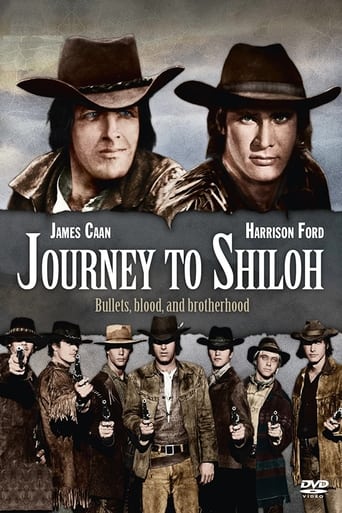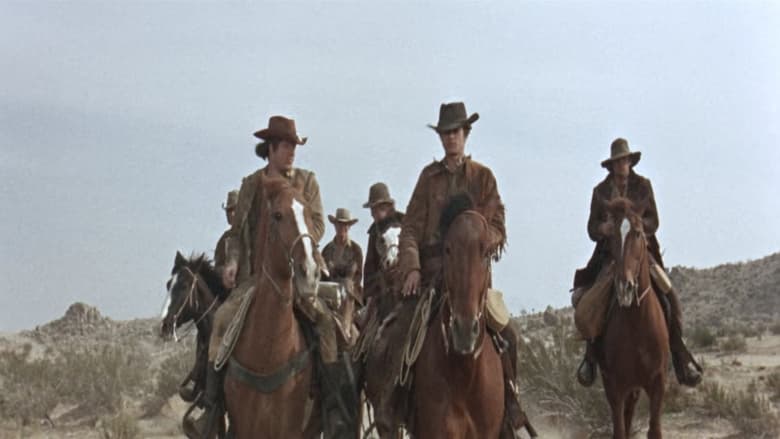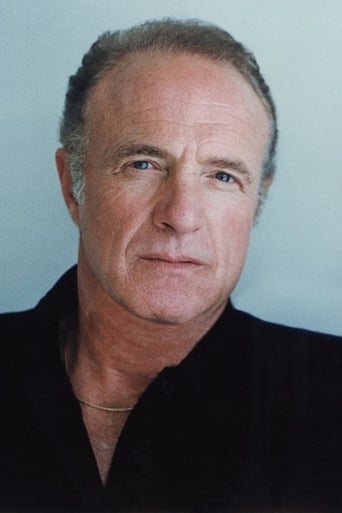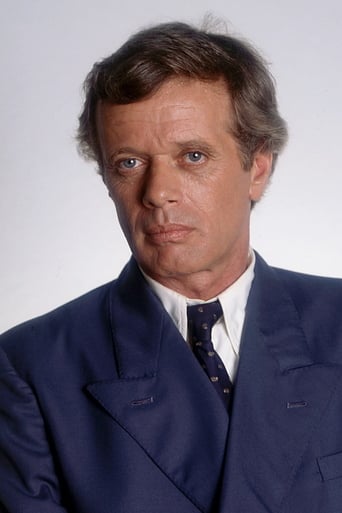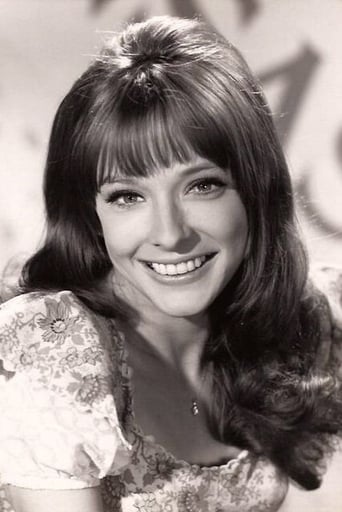Journey to Shiloh (1968)
At the beginning of the Civil War, seven friends embark on a cross-country journey in order to join the Confederate army.
Watch Trailer
Free Trial Channels
Cast


Reviews
I like the storyline of this show,it attract me so much
Some things I liked some I did not.
Watch something else. There are very few redeeming qualities to this film.
This is a gorgeous movie made by a gorgeous spirit.
Journey to Shiloh is directed by William Hale and adapted to screenplay by Gene L. Coon from the novel written by Will Henry. It stars James Caan, Michael Sarrazin, Brenda Scott, Albert Popwell, Harrison Ford, Jan-Michael Vincent, Robert Pine and Noah Beery Junior. Music is by David Gates (supervision Joseph Gershenson) and Technicolor cinematography by Enzo Martinelli.Seven young Texans journey east to fight for the Confederacy in the Civil War. Full of ideas of noble glory for the war effort, the group have their eyes rudely opened by the prejudice and snobbery they encounter along the way.Rock of Ages.Film is bookended by a cheesy song that first tells of the young men setting off for the journey, then latterly of what became of them upon their final destinations. Throw in some pretty wooden acting away from the lead player and mix in a score that sounds like it belongs in the Pink Panther cartoon show, well you would naturally expect the film to be something of a disaster? Yet there is much to recommend here for the discerning fan of Civil War yarns.The Pensacola Light Blues.Picture gets its strength from the interest garnered by the source story and the lead performance by a youthful, wig wearing, Caan. Story is potent as an anti-war piece, the parallels with the then current Vietnam War, and the feelings running high at that time, are hard to ignore. Here the lads have their ideals punctured by events that happen out on the trail. Firstly some in fighting upsets the equilibrium and this sets the tone for the rest of the picture. An encounter with a runaway slave, and the aftermath of said encounter, really puts a serrated edge on the plotting. Young men off to be brave and fight the good fight, do they know what for? They then are surprised by public resistance to their bravado, you see not everyone wants a war, lads.Cos we're fixin to shove that there General Grant and them blue bellied soldiers of his-plum into Lake Erie.A pointless romantic interlude threatens to derail the picture, but the makers overcome it by dropping in some good action. A bar room brawl at Munroe is most enjoyable, and then once the guys find themselves enlisted into the Pensacola Light Blues, with Beery Junior arriving and putting his mark on the picture, we move onto the horrors of war. Here we lurch onto The Battle of Shiloh (AKA: Battle of Pittsburgh Landing) which is resplendent with artillery galore and much flinging around of stunt men. It's well constructed but sadly too short in length. Filmed out of Agoura in California, the scenery is an extra bonus and an enjoyable character accompaniment as story unfolds.All told it's a mixed bag of a viewing, but the good far outweighs the bad to make this a sleeper of an Oater worth seeking out. While future stars of film and TV taking tentative steps in the acting world also holds a high interest factor here. 7/10
A handful of Texas cowboys make the journey a thousand miles east to fight at the Battle of Shiloh. They're a varied lot. The most mature of the bunch is James Caan who has an easy smile, a cowboy hat with a white feather sticking out of the band, and he always says "Yes, sir," and "No, Ma'am." There is some talk of who is the fastest gun. There is the occasional outbreak of some abrasive feelings in the group but on the whole they're a good old bunch.I found it predictable, unimaginative, and boring. The men wear the long, carefully groomed styles of long hair found among the hep cats of 1968. The women folk have long hair too, and even longer eyelashes, some as long as the marquees that stretch out over the lawn at a fancy outdoor wedding. A good thing there was no wind. I winced when the character said over a man dying of a gunshot, "Get that preacher in here. He purely could use some readin' over." The script defies anything resembling credibility. During a stop over in a small town, Caan meets the uber-yummy Brenda Scott, who practically salivates over him and invites him to stay with her overnight because she ain't never met nobody as nice as him before. This happens to me all the time, but I have this cloud of pheromones I carry around with me and it's clear James Caan doesn't. It's true. A beautiful woman once fainted while walking past me in Julius's in the Village before it went gay. Couldn't take my molten hotness, I guess.I have a good deal of respect for hastily assembled and inexpensive Westerns but this one has no poetry. You know what this movie would have been good for? You take your girl to the drive in movie theater in 1968 Sweetwater, Texas, and then you turn down the volume, roll up the windows, and roll around in the back seat until the windows are all fogged up. Once having gotten that out of the way, you clamber back into the front seat, turn the volume back up, and doze off. But you can only do that if you're under twenty-one.
I saw the very young Harrison Ford and had to watch this late 1960s action film about 7 friends from west Texas who are drawn into their imagined adventure of joining the American Civil War and fighting for the Confederate States (south). Harrison Ford probably has the fewest lines of the seven friends. What happens on the journey? Everything goes wrong. In fact, they do not make it to their destination, Virginia. Their ideals begin to drop off, along with their numbers, along the way as they see a runaway slave being hung from a tree. They encounter prejudices against them as they try to join upper-class party in east Texas, dishonesty at a saloon gambling game in Louisiana, and the bloody severity of war at The Battle of Shiloh.The strong premise about the destructiveness of war and civil rights is obvious, but offered up with a "teenage adventure" smile on the easy to criticize setting of the South during the Civil War. This may have been one of the earliest anti Vietnam War movies out of Hollywood and is worth watching to see how an anti-war message was beginning to come out of Hollywood. You can see the conflicting messages as The Green Berets was made the same year.There are some historically accurate portrayals that are worth seeing, such as 2 different treatments of African-Americans - one had a comfortable life and another was lynched. Some of the battlefield scenes looked like they were taken from another movie. And what happens to the main character at the end is a surprise, but keeps with the premise.
1968's "Journey to Shiloh" was made a couple years too early to be classified as a "counterculture antiwar" film, it was about the same time as John Wayne's "Green Berets", while most of the country was still solidly behind the war and only barely beginning to waiver. The story and the theme are virtually identical to a 1959 German film "Die Brucken", in which seven just inducted teenage boys watch as cynical Wehrmacht soldiers evacuate their town ahead of approaching American troops. Full of enthusiasm for the "blood and honor" of patriotic ideology, the seven boys stay to defend a useless bridge. Both films are somewhat unusual anti-war pictures because the enemy is essentially faceless and the theme derives more from the tragedy of easily influenced and manipulated young people. Aside from the obvious California scenery (which cannot even remotely pass for Texas or Mississippi), the absurd physical miscasting of John Doucette as General Braxton Bragg, and a rather weak battlefield sequence; "Journey to Shiloh" is reasonably accurate historically. I'm from Tom Green County, Texas (just west of Concho and Menard Counties- where the characters are from) and the boys' journey to get into the far away war was not uncommon for West Texas; where young men went to war seeking adventure without much clue what the fight was really about. Calling these actors "boys" requires considerable suspension of disbelief as most of them were in their mid to late 20's. James Caan is the leader, the story is told from his point of view and he gets the vast majority of the screen time. Other sixties notables in the group are Michael Sarrazin, Paul Petersen, Jan-Michael Vincent, and Harrison Ford (who gets the least screen time-yet would become the most famous). Interestingly, even the remaining two had their claims to fame. Michael Burns played Benjie "Blue Boy" Carter in the all-time camp classic "Dragnet" episode about the evils of LSD; the drug caused him to paint his face blue (years before Mel Gibson). And Don Stroud's portrayal of Lamarr in "Joe Kidd" might be the finest piece of overacting in cinema history. Other notables in the cast are Rockford's dad and Ann Sothern's daughter Tisha Sterling. Sterling was an extremely promising actress in the late sixties (and my personal favorite) who in an ideal world would have had a lot more good roles. Here she plays a patriotic southern belle named Airybelle Sumner, who in the film's best scene inspires the boys (men) to fight for the noble honor of the south. They soon learn that her view of the south is somewhat at odds with reality. "Journey to Shiloh" does not deserve its obscurity. It has its faults but is gripping entertainment with an important message. Considerably better than most films from the time period. Then again, what do I know? I'm only a child.

